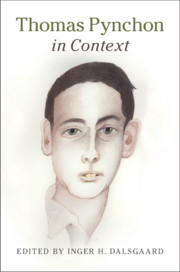Book contents
- Thomas Pynchon in Context
- Thomas Pynchon in Context
- Copyright page
- Contents
- Contributors
- Abbreviations
- Chronology
- Introduction
- Part I Times and Places
- Part II Culture, Politics, and Society
- Part III Approaches and Readings
- Chapter 34 Narratology
- Chapter 35 Genre
- Chapter 36 Postmodernism
- Chapter 37 Ambiguity
- Chapter 38 Realities
- Chapter 39 Material Readings
- Chapter 40 Digital Readings
- Chapter 41 Internet Resources
- Chapter 42 Fandom
- Chapter 43 Book Reviews and Reception
- Chapter 44 Critical Literature Review
- Further Reading
- Index
Chapter 37 - Ambiguity
from Part III - Approaches and Readings
Published online by Cambridge University Press: 31 May 2019
- Thomas Pynchon in Context
- Thomas Pynchon in Context
- Copyright page
- Contents
- Contributors
- Abbreviations
- Chronology
- Introduction
- Part I Times and Places
- Part II Culture, Politics, and Society
- Part III Approaches and Readings
- Chapter 34 Narratology
- Chapter 35 Genre
- Chapter 36 Postmodernism
- Chapter 37 Ambiguity
- Chapter 38 Realities
- Chapter 39 Material Readings
- Chapter 40 Digital Readings
- Chapter 41 Internet Resources
- Chapter 42 Fandom
- Chapter 43 Book Reviews and Reception
- Chapter 44 Critical Literature Review
- Further Reading
- Index
Summary
One of the most important early studies of Thomas Pynchon’s fiction is Thomas Schaub’s Pynchon: The Voice of Ambiguity (1981), which, more than thirty years later, is still an essential resource because ambiguity remains the single greatest obstacle for the reader of Pynchon. That is to say, ambiguity characterizes every aspect, formal and thematic, of Pynchon’s narrative project – for readers both inside and outside the storyworlds his narratives create. As Schaub points out, characters are caught between facts or actions and their possible meaning(s), as is the external reader of narratives that refuse to align literary form with meaning. These fictional worlds not only lack certainty but are constructed to suggest that an order exists but is withheld and remains unknown because it is unnamed, experienced only in suspicions. Coexisting possibilities emerge from the tension between the fragmentary experiences of characters that inhabit a diegetic world in decline, hinting at the existence of a dimension of unified, continuous meaning with the potential to offer renewal if not redemption.
- Type
- Chapter
- Information
- Thomas Pynchon in Context , pp. 298 - 306Publisher: Cambridge University PressPrint publication year: 2019



